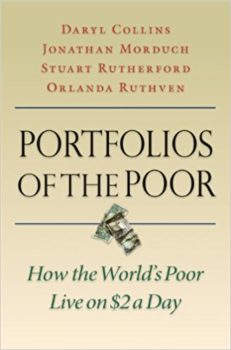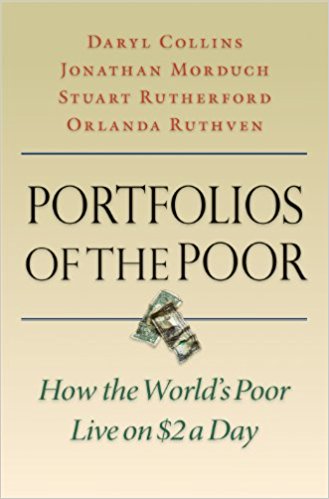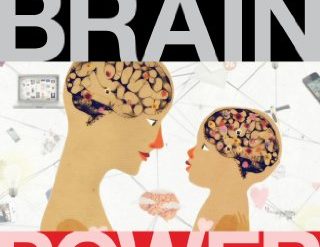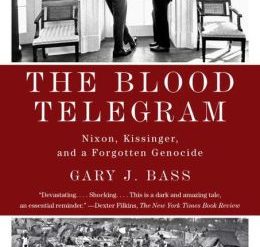
This book makes a major contribution to our understanding of global poverty.
Portfolios of the Poor reports the findings of a series of detailed, year-long studies of the day-to-day financial practices of some 250 families in India, Bangladesh, and South Africa, including both city-dwellers and villagers. The authors conducted monthly, face-to-face interviews with each family, focusing on money management and recording every penny spent, earned, or borrowed in “diaries” that formed the principal source for their observations.
Surprising discoveries from the authors’ research
In the process, the authors made discoveries that will surely be surprising to some readers:
- The poor rarely live from hand to mouth. “[N]o matter where we looked, we found that most of the households, even those living on less than one dollar a day per person, rarely consume every penny of income as soon as it is earned. They seek, instead, to ‘manage’ their money by saving when they can and borrowing when they need to.”
- Lack of money is just one of the financial characteristics of poverty. It’s equally important that poor people’s income is both unpredictable and irregular. Crops come in two or three times a year, yielding whatever the weather may permit and the market may bear; between-times a family may have no cash income at all. A son might get a job for a day but not again for a week or a month. Illness or injury may interrupt a family’s income. And so forth.
- Rather than helpless victims of their poverty, the authors found, the poor are remarkably sophisticated about the financial circumstances of their lives. “We came to see that money management is, for the poor, a fundamental and well-understood part of everyday life.”
- Microlending is just one of the financial services needed by the poor to lift themselves out of poverty. “[W]e saw that at almost every turn poor households are frustrated by the poor quality — above all the low reliability — of the instruments that they use to manage their meager incomes. This made us realize that if poor households enjoyed assured access to a handful of better financial tools, their chances of improving their lives would surely be much higher.”
Portfolios of the Poor: How the World’s Poor Live on $2 a Day by Daryl Collins, Jonathan Morduch, Stuart Rutherford, Orlanda Ruthven (2009) 315 pages ★★★★☆
Most observers regard money-lenders as simply a scourge of the poor, as they are so very often. However, given the dearth of mainstream money-management alternatives, there are many circumstances in which it’s logical for poor people to turn to money-lenders for short-term cash loans. “One of the lessons from the diaries is that interest paid on very short-duration loans is more sensibly understood as a fee than as annualized interest.”
Scholars, activists, and policymakers alike have quarreled over the question of global poverty and what to do about it for more than half a century. More often than not, the disputes they air in official policy debates, in the news media, and in scholarly journals are grounded in statistics developed by the United Nations and the World Bank — figures that usually represent worldwide averages. Therein lies much of the trouble.
What does “$2 a day” really mean?
The most widely accepted benchmark for world poverty today is $2 a day per person, as determined by the World Bank. However, you have to dig deeply before you can understand what the World Bank and the United Nations actually mean by “$2 a day.” They’re not referring to those two one-dollar bills you may have crumpled up in your pocket or purse. To correct for economic differences from one country to another, they use the concept of Purchasing Power Parity (PPP).
In theory, PPP takes into consideration the sharp differences in how much $2 will buy in any given country as compared to the global norm. But in practice the experts have widely differing views on what method should be used to calculate PPP and, in effect, what is the global norm. As if that isn’t bad enough, the most commonly used techniques to calculate PPP are based on each country’s economy-wide standard of living. In other words, the definition of poverty might depend in part on the price of big-screen TV sets and BMWs or their equivalent. In hopes of correcting that problem, scholars have been writing papers for several years about “poverty-based PPP,” excluding anything but goods and services commonly demanded by people living at subsistence level, but none of the approaches they’ve proposed has yet been officially adopted.
The authors reject Purchasing Power Parity (PPP)
The whole question of PPP, then, is so confusing — and so confused — that the authors of Portfolios of the Poor have rejected the concept. They base all their calculations simply on the prevailing exchange rates between local currencies and the U. S. dollar. To which I say, amen.
The four co-authors of this book are an intriguing bunch. Two are men and two women. (Daryl Collins, the lead author, is female.) All four are products of elite universities: Oxford, Cambridge, Harvard, and the London School of Economics, though only one, Jonathan Morduch, is currently an academic. Morduch teaches development economics at NYU’s Wagner School of Public Policy in New York; he is an expert in microfinance. Daryl Collins, Stuart Rutherford, and Orlanda Ruthven are all development practitioners with practical field experience — Collins with a Boston-based global consultancy, Rutherford with a microfinance institution he founded in Bangladesh, and Ruthven with DFID, the UK equivalent of USAID.
For further reading
This is one of 20 top books about Africa, including both fiction and nonfiction and of Good books about economic inequality.
It’s also one of the books I’ve included in my post, Gaining a global perspective on the world around us.
For books on closely related topics, see:
- Narrowing global inequities: a reading list
- Third World poverty and economic development: a reading list
- The top 10 books on the economics of poverty
- A resource list on social enterprise
And you can always find my most popular reviews, and the most recent ones, plus a guide to this whole site, on the Home Page.



























Your review makes me want to read the book. Having grown up in a poor family, I truly resonated with your statement about the inconsistency of income being a factor in poverty. That is one of the biggest challenges of being poor as well as working even in the US in the freelance, temp-gig-world so many of us have been thrust into in this economy. Thanks, as always, fo your reviews.
“Eradicate extreme poverty and hunger” is the first of the eight Millennium Development Goals (MDGs) adopted in 2001 by the 192 United Nations member states and 23 international organizations. One target is to halve the proportion of the world’s population living on less than $1 a day (PPP values). A 2009 report by the UN Population Fund warned that overall progress has been too slow for most of the MDG targets to be met by the target date of 2015. And major advances in the fight against poverty have begun to slow or even reverse as a result of the global economic crisis.